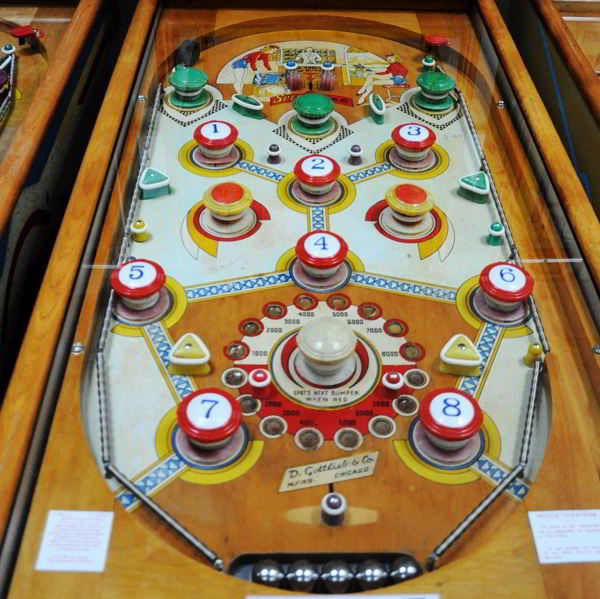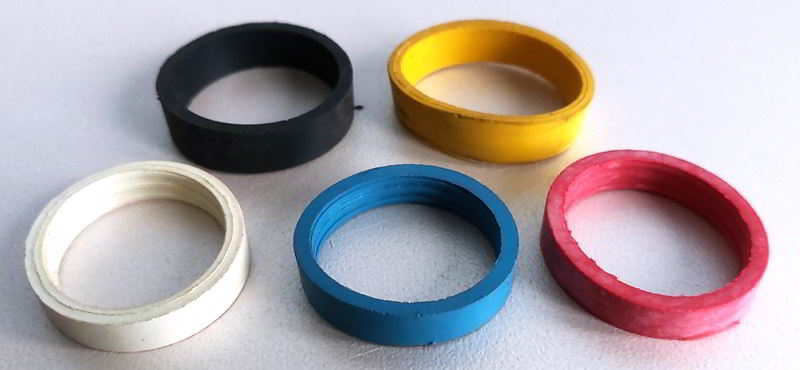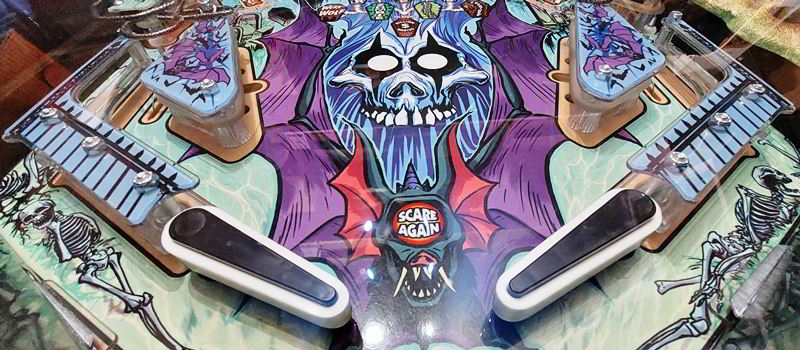Pinball rubbers
Rubber rings are in use on pinball machines since (around) 1939. Before that, pinball games had metal springs around the borders of the playfield. Most targets a player could hit with the steel ball, were also made out of metal. In 1939 some games were released with passive bumbers that had a white rubber ring around them. This allowed the ball to bounce much better. On early machines like Chief they were sparingly used, only on a few bumpers.

Bally Bumper of 1936, no rubber to see, only metal springs.
By the end of 1939, some manufacturers had switched and created playfields where new rubber rings replaced the metal springs from before. An example of this is Roller Derby. Metal springs remained in use the years that came, but started to be replaced more and more by rubber rings.

This Belle Hop machine from 1941 uses rubber rings on the components in the center, and metal springs on both edges of the playfield.
As pinball machines evolved, white rubber rings had found their place and remained one of the important playfield parts to interact with the pinball. Rubber rings were here to stay.
‘The ball is wild’, a famous quote by designer Harry Williams is related to this. Rubber rings are an important aspect of what gives a pinball machine its unique feel. They alter the path of the pinball in unpredictable directions. A spinning ball can suddenly stop spinning and roll away after bouncing off a rubber ring.
For decades, the default setup of a playfield was to use white rubber rings. Games with small 2.5 inch flippers also had white flipper rubbers. In the 1970ies when the larger 3 inch flipper rubbers were introduced, manufacturers started to experiment with other types of flipper rubbers. Each of them had their distinct size and color. In the 1980ies most had defaulted to regular red rubber rings. Red felt good, it was the right amount of softness / bounciness.
All rings were made from natural rubber, which has a white color. It’s possible to create colored rings by adding colored additives to it. In general, the durometer (hardness) changes with the color. The darker a color, the more additives and the harder rubber becomes. Yellow flipper rubbers will bounce a lot, red less, and on black flipper rubber a pinball sometimes almost falls dead and hardly bounces.

Flipper rubbers in different colors.
In the 1990ies, manufacturers made a switch and started to ship their new pinball machines by default with black rings installed, instead of white rings. This was on request of operators. Black rubbers were better for their exploitation: they last longer (softer white rubbers will sooner wear and break). You don’t see dirt on them, so an operator can clean them less often. Black rubber rings were harder and didn’t bounce the pinball around so much. So unfortunately, while being better for operators, they’re not better for players.
When people now shop their game they sometimes want to make it original and install black rings. This may not be the best choice. Although the layout of pinball machines changed: gameplay became faster, playfields had less rubber rings and more metal ball guides, pinball designers usually still used white rubber as standard to design and tune their layouts. If you want to stay true to how a designer intended the game to play, you’d stick with white rubber, especially with the early WPC machines.
The difference in gameplay is noticeable. For instance, on games like Attack From Mars and Medieval Madness, you need to make a certain hits of the pop bumpers. In a machine with black rubber rings, you’ll notice you need much more shots into the bumpers to reach the goals. In a white rubbered playfield, the pinball is more wild and will stay longer in the popbumper area each time.
Pinball designers could request exceptions to the black rubber. No Good Gofers for instance still shipped with white rubber (and a real backglass and not a translight), because Pat Lawlor requested it explicitly. As layouts changed, some designers did design games for black rubber or a specific durometer. Fast games like Steve Ritchie usually creates, don’t need extra bounce.
It took another decade, until a subtle change was made. The black rubber on the market, and what Stern Pinball installed by default on their new machines had changed. It couldn’t be compared anymore to the hard black rubber of the 1990ies.
A new type of black rubber was developed that was about as soft as white rubber. Or rings were even available in different durometers - while they all looked like the same black rings, they felt and played different.
The old mantra of ‘black rubber is hard, white is soft, suddenly wasn’t valid anymore.
This makes it difficult for collectors now to decide what to install. The black rings all look the same. Did a game ship with soft or harder black rings ? Or should it need white instead of black rubber ?
It becomes more a matter of taste and personal feeling. Sometimes you have to experiment to find what plays best on your specific machine. On machines with a fast layout, less bouncy rubber may play better.
It was also in the middle of the 2000s that on the spare parts market other colored rubbers became available. Rings, flippers and post sleeves became available in a whole array of colors. Collectors who shopped their games didn’t want only black or white, but could match colors that fit the theme of the game and colors on the playfield. Together with adding colored leds, aligning colors and how something looks, became much more important to collectors.
The last evolution came a few years later. Instead of the rings being made out of rubber, silicone based and other types of rings were developed. Available in all different types of colors, even light-in-the-dark. These new bands do feel and play different. They have advantages, like not wearing fast. Natural rubber rings will dry and harden under the influence of UV light. White rings will yellow. These new rings stay soft for much longer.
Some players like them, some don’t. Rings are soft and bounce more than rubber, but at the same time, flipper rubbers seem to have more grip. It’s a totally different feeling, you have to adjust your style of playing and calculating when you want to catch a pinball on a flipperbat.
While the larger manufacturers still use rubber rings on new games, smaller ones like Spooky Pinball do ship their games by default with the new silicone rings (on Alice Cooper for example).
Most pinball shops sell all kinds of flipper rubbers, in rubber and other material. Here you can see the largePinballshop.nl has a large amount of different rubbers for sale at pinballshop.nl (affiliate link).

Alice Cooper playfield with glow in the dark flipper rubbers and silicone rings on the slingshots.
